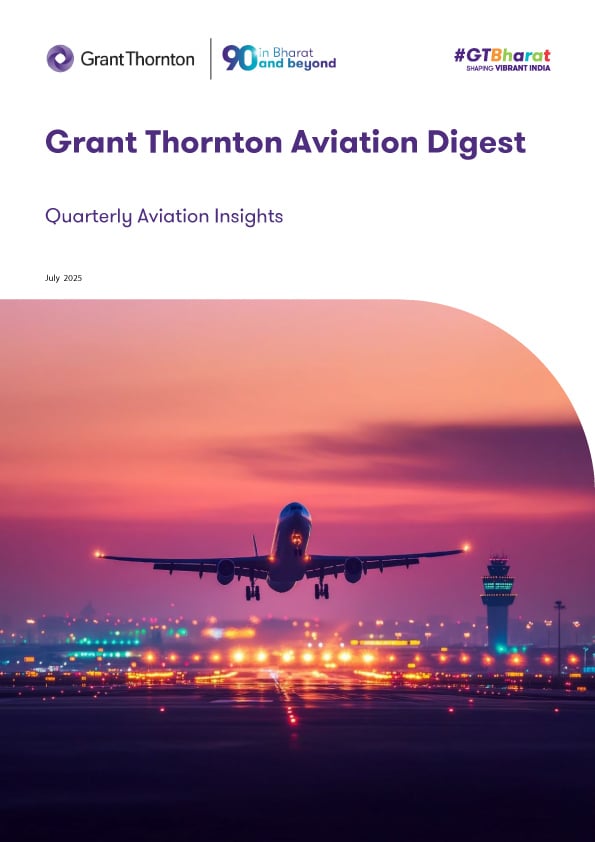-
Business Consulting
Our business consulting specialists offer a comprehensive blend of strategic advisory services. We assess the business, industry, operating model, synergy, skill sets and vision of the organisation and recommend the way forward
-
Digital Natives
Unlock growth with Grant Thornton Bharat's Digital Natives solutions. Customised support for tech-driven companies in healthcare, gaming, and more.
-
New and Emerging Tech
In a world where change is constant, staying ahead means staying adaptable. At Grant Thornton Bharat, we believe the future belongs to those who can evolve quickly, leveraging new and emerging technologies not just as trends, but as strategic levers for transformation.
-
Finance Transformation
Using a holistic approach, integrating digitalisation and digital transformation we help clients achieve transparency, control, governance, and faster decision making through real-time data within the business.
-
Human Capital Consulting
Our Human Capital Consulting team harnesses technology and industry expertise to assist in constructing adaptable organisations with transparency, fostering productive and value-driven workforces, and inspiring employees to engage meaningfully in their tasks.
-
Production Linked Incentive Scheme
Production-linked Incentive Scheme by the Indian government is aimed at boosting manufacturing. Grant Thornton Bharat offers varied services across sectors to help businesses avail of this scheme.
-
Public Sector Advisory
Our Public Sector Advisory team has focused streams, aligned with the core priorities of the Government of India. We are responsible for providing innovative and customized technical and managerial solutions.
-
Tech Advisory
We have amalgamated Digital Transformation, IT Advisory & Information Management and Analytics into a new offering, DigiTech.

-
Direct Tax services
Our tax specialists offer a comprehensive blend of tax services, tax litigation, regulatory and compliance services, helping you navigate through complex business matters.
-
Indirect Tax Services
Get tax services by leading tax firm Grant Thornton India. Our indirect tax services include consulting, compliance and litigation services for corporate, international and transaction tax
-
Transfer Pricing
Our transfer pricing services experts provide a range of services from provision of APA services to handling large global assignments including Country by Country reporting.
-
US Tax
At Grant Thornton, we help individuals and dynamic companies deal with US tax laws, which are one of the most complicated tax legislations across the world.
-
Financial Services - Tax
Best financial consulting services, tailored for small and large businesses by the experts having comprehensive knowledge of domestic laws and access to multifaceted tools to provide a valuable results.
-
Financial Reporting Advisory Services
Our experts have significant hands-on experience in providing IFRS/US GAAP services, end-to-end solutions and support services to fulfil financial reporting requirements.
-
Fund accounting and financial reporting
International operations often lack standardisation and have varied local reporting formats and requirements. Our experts can offer proactive insights, practical guidance, and positive progress and help meet regulatory timeframes.
-
Compliance and Secretarial Services
Our experts can assist in overhauling the entire compliance machinery of the organisation through evaluation of the applicable statutory obligations, monitoring of adequate governance controls, reporting and providing ongoing support.
-
Global People Solutions
As businesses transcend borders, both domestic and global considerations need equal attention. Our interim CFO and financial controller support services help organisations meet the business vision.
-
Finance and accounting outsourcing
Our accounting experts assist organisations in managing their accounting and reporting. Our dedicated Integrated Knowledge and Capability Centre (IKCC), allows us to service both the domestic and global markets efficiently and cost-effectively
-
Compliance Management System
We have automation solutions for you that will allow meeting government requirements and remain diligent, which when failed, can lead to penalties and loss in revenue.
-
Centres of Excellence
Strategic business hubs for global delivery
-
Global compliance and reporting solutions
At Grant Thornton Bharat, we meet the challenges of our clients and help them unlock their potential for growth. Our professionals offer solutions tailored to meet our clients’ global accounting and statutory reporting requirements. With first-hand experience of local reporting requirements in more than 145+ locations worldwide, we provide seamless and consistent international service delivery through a single point of contact.
-
Related-party transaction governance
Related-party transactions (RPTs) are common in business structures where organisations engage with their group entities, such as holding companies, subsidiaries, associate concerns, joint ventures, or key management personnel, for various operational or financial purposes.
-
Family Offices and Private Client Services
Grant Thornton Bharat Private Client Services offers tailored consulting for family-owned businesses, focusing on governance, compliance, tax, succession planning, and family office structuring to sustain wealth and preserve legacies across generations.
-
Labour codes
Labour codes solutions help you transition through the new legislation. At Grant Thornton, we help businesses divide their approach to make sure a smooth transition.
-
Alerts
At Grant Thornton India, with the help of our tax alerts, we help to provide updates on how to minimise your tax exposure and risks.
-
India investment roadmap
The India Investment Roadmap resource is designed to navigate the complexities of Indian tax and regulatory laws, providing seamless guidance and a comprehensive set of solutions to ensure a smooth process for investors aiming to establish or expand their presence in India.
-
CFO Solutions
Our comprehensive suite of solutions for CFOs

-
Crisis and Resilience
Cyber risks, financial crime and regulatory scrutiny demand strong preparedness. Our forensic team helps organisations build robust crisis and resilience frameworks to protect value and maintain trust.
-
Cyber
In today’s time, businesses have gone through large transformation initiatives such as adoption of digital technologies, transition to cloud, use of advanced technologies et al.
-
ESG consulting
Grant Thornton Bharat offers holistic ESG consulting solutions for sustainable business outcomes. With industry expertise and AI technology, we drive long-term value.
-
Risk analytics
Grant Thornton Bharat’s CLEARR Insights is a state-of-the art data analytics platform that will help you in seamless data analysis and efficient decision-making.
-
Forensic & Investigation Services
The team of forensic consulting services experts consists of the best intelligence corporate experts, and fraud risk, computer forensic experts to deliver most effective solutions to dynamic Indian businesses.
-
Risk Optimisation
Our Governance, Risk and Operations (GRO) services encompass Internal Audit, Enterprise Risk Management, Internal Financial Controls, IT advisory, Standard Operating Procedures and other services.

-
Deal Advisory
Unlike other M&A advisory firm in India, we offer deal advisory services and work exclusively with controlled and well-designed strategies to help businesses grow, expand and create value.
-
Due Diligence
Grant Thornton’s financial due diligence services are aimed at corporate looking for mergers and acquisitions, private equity firms evaluating investments and businesses/promoters considering sale/divestment.
-
Debt & Special Situations Solutions
Grant Thornton Bharat offers specialist debt and special situations consulting services, including restructuring, insolvency, and asset tracing solutions.
-
IPO Services
Grant Thornton Bharat’s IPO services ensure optimal scaling of organisations in the financial markets
-
Transaction Tax Services
Our transaction tax experts understand your business, anticipate your needs and come up with robust tax solutions that help you achieve business objectives ensuring compliance and efficiency
-
Overseas Listing
Overseas listing presents a perfect platform for mid-sized Indian companies with global ambitions. Grant Thornton’s team of experts in listings, work closely with clients during all stages.
-
Valuations
Valuation services are central to every deal lifecycle — from pre-deal strategy to post-transaction integration. Grant Thornton Bharat delivers precise, compliant, and defensible valuations across regulatory, financial reporting, and transaction contexts. Our experts apply deep technical and sector insights to ensure fair value, mitigate risk, and support decision-making for M&A, private equity, litigation, and intangible assets. Every deal begins with the right value — we help you discover it.
-
Financial Reporting Advisory Services
Grant Thornton Bharat Financial Reporting Advisory Services offer end-to-end solutions for complex financial requirements, including GAAP conversions, IPO support, and hedge accounting advisory, ensuring accurate financial reporting and compliance.
-
Financial Statement Audit and Attestation Services
Grant Thornton Bharat offers customised financial statement audit and attestation services, ensuring impeccable quality and compliance with global standards. Our partner-led approach, technical expertise, and market credibility ensure effective solutions for your business needs.

- Agriculture
- Asset management
- Automotive and EV
- Banking
- Education and ed-tech
- Energy & Renewables
- Engineering & industrial products
- Fintech
- FMCG & consumer goods
- Food processing
- Gaming
- Healthcare
- Urban infrastructure
- Insurance
- Media
- Medical devices
- Metals & Mining
- NBFC
- Pharma, bio tech & life sciences
- Real estate and REITs
- Retail & E-commerce
- Specialty chemicals
- Sports
- Technology
- Telecom
- Tourism & hospitality
-
 Thought leadership Co-lending in India: Expanding credit access for MSMEsIn today’s rapidly evolving financial landscape, co-lending has emerged as a key enabler of credit expansion in India, facilitating partnerships between banks and non-banking financial companies (NBFCs) to extend credit more efficiently to underserved segments.
Thought leadership Co-lending in India: Expanding credit access for MSMEsIn today’s rapidly evolving financial landscape, co-lending has emerged as a key enabler of credit expansion in India, facilitating partnerships between banks and non-banking financial companies (NBFCs) to extend credit more efficiently to underserved segments. -
 Article Why India’s financial inclusion journey needs to focus on equity and access to creditFinancial services have expanded over a decade, giving millions access to bank accounts and digital payments. But true empowerment needs to reach every corner of the country if growth is to be long-term and sustained
Article Why India’s financial inclusion journey needs to focus on equity and access to creditFinancial services have expanded over a decade, giving millions access to bank accounts and digital payments. But true empowerment needs to reach every corner of the country if growth is to be long-term and sustained -
 Thought Leadership Competitive and sustainable agriculture & food processing in KeralaThe economy of Kerala is primarily driven by the services sector, which contributes 66% to the Gross State Domestic Product (GSDP).
Thought Leadership Competitive and sustainable agriculture & food processing in KeralaThe economy of Kerala is primarily driven by the services sector, which contributes 66% to the Gross State Domestic Product (GSDP). -
 Article Economic Survey 2024-25: Deregulation, investment and innovation for a Viksit BharatIndia's economic growth remains for a steady trajectory with real GDP expected to grow at 6.4% in FY25 and in the range of 6.3%-6.8% in FY26, reflecting resilience despite global uncertainties.
Article Economic Survey 2024-25: Deregulation, investment and innovation for a Viksit BharatIndia's economic growth remains for a steady trajectory with real GDP expected to grow at 6.4% in FY25 and in the range of 6.3%-6.8% in FY26, reflecting resilience despite global uncertainties.
-
Quarterly Aviation Insights
Explore the latest trends in aviation industry with Grant Thornton Bharat’s Quarterly Aviation Insights. Stay updated on industry growth, market shifts & key developments.

-
Freight Forward: Quarterly insights
Logistics sector in India is adapting to rising costs, global disruptions, and the growing urgency of sustainability.
-
India-UK
India-UK
-
India - Japan
India - Japan

Despite global challenges such as inflation, rising fuel prices, and geopolitical uncertainties, India's aviation ecosystem remains robust. Domestic air travel growth continues to surge, driven by affordability, regional connectivity schemes, and improved service offerings by legacy and low-cost airlines. The foundation of this growth lies in structural policy shifts, private and foreign investments, and government spending, all of which form the focus of this aviation newsletter.
Air passenger traffic Jan–Apr 2025 indicates strong momentum
From January to April 2025, the total number of passengers carried by domestic airlines reached 575.13 lakh, reflecting a significant rise from 523.46 lakh during the same period the previous year. This translates to an annual growth of 9.87% and a monthly growth rate of 8.45%. IndiGo maintained its lead with a year-to-date market share of 64.3%, while the Air India Group held 26.7%, Akasa Air 4.9%, and SpiceJet 2.9%. These figures underscore the domestic sector's strength and resilience, revealing how rapidly demand for air travel is growing across both major metros and tier-2 cities.
Infrastructure expansion powers airport development projects nationwide
India's commitment to aviation infrastructure is evident in the sharp rise in operational airports—from just 74 in 2014 to 162 in 2025. Under the UDAN scheme and broader aviation policy in India, over 50 new airports are in various stages of planning and construction. These include major greenfield airport development projects like Noida International Airport and Navi Mumbai International Airport, both of which are scheduled to begin operations in 2025. Noida International Airport is being developed with advanced multimodal connectivity and is expected to handle up to 70 million passengers annually once fully built out. Meanwhile, Navi Mumbai International Airport will cater to an estimated two crore passengers annually, with integrated domestic and international terminals designed to global standards.
Digital transformation is also becoming integral to airport development projects in India. Key hubs such as Delhi, Hyderabad, and Mumbai are undergoing upgrades, including biometric security, AI-driven baggage handling, predictive air traffic control, and electric-powered ground services. These initiatives align with India’s sustainability goals while improving passenger experience and operational efficiency.
MRO industry takes off with localisation and innovation
The MRO industry in India is undergoing a significant transformation, reducing dependence on overseas facilities and building domestic capability. The growing aircraft fleet, including over 700 planes currently in operation and hundreds more on order, is creating high demand for advanced maintenance services. Air India has already begun centralising its Continuing Airworthiness Management Organisation (CAMO) operations in the Delhi-NCR region, with approval for in-house interior modifications. Such steps reduce turnaround times and boost local employment and technical expertise.
The government's support has played a pivotal role in this shift. Lowering GST on MRO services to 5%, easing regulatory hurdles, and incentivising domestic capacity-building are all part of a policy effort to strengthen India’s aerospace backbone. The sector’s projected growth—from USD 900 million in 2022 to over USD 4 billion by 2031—demonstrates the potential of a strong MRO ecosystem. Investment in digital tools, predictive maintenance systems, and real-time diagnostics is further reshaping aircraft maintenance trends, improving safety and profitability.
Strategic advisory for airport projects and beyond
Recognising the complexity and opportunity within India’s aviation ecosystem, Grant Thornton Bharat has developed a specialised airport financial advisory service to guide stakeholders through the full lifecycle of aviation projects. This includes transaction support for greenfield airport development, brownfield expansion, airport PPP advisory, and emerging aviation segments such as drone traffic management and urban air mobility corridors. The offering also extends to MRO project bids, airline maintenance contracts, and airport services such as cargo handling, in-flight catering, security, and IT infrastructure.
Grant Thornton’s solution rests on three interconnected capabilities: market assessment, financial modelling, and bid submission strategy. The advisory service empowers clients to submit winning, technically sound bids that are financially viable and strategically aligned with India's evolving regulatory frameworks through detailed traffic forecasting, competitive analysis, CAPEX/OPEX validation, and dynamic financial models. With this integrated approach, the firm positions itself as a consultant and a strategic partner for clients aiming to thrive in one of the world’s most promising aviation markets.
Dual investment engine: Public capital and FDI drive sector growth
A combination of sustained government expenditure and growing foreign direct investment powers India’s aviation investment strategy. Public funding continues to flow into airport upgrades, air traffic management systems, and connectivity schemes such as UDAN. The government has also privatised several major airports under the PPP model and encouraged private participation in ground services, security, and catering.
Conversely, progressive policy frameworks and streamlined approval mechanisms have attracted record levels of FDI. In 2023 alone, total foreign inflows exceeded USD 71 billion, including significant investments in aircraft leasing, component manufacturing, and the MRO ecosystem. The passing of the Cape Town Convention-aligned legislation in 2025 is further expected to catalyse leasing and aviation finance investments. Together, these public and private capital flows are creating a synergistic growth cycle that strengthens India’s competitiveness on the global aviation stage.
The future of flight: Urban air mobility and smart redevelopment
India is looking ahead to the next frontier in aviation through airport funnel redevelopment and urban air mobility innovations. In Mumbai, recent policy changes allow the transfer of unused Floor Space Index (FSI) via Transferable Development Rights (TDR), encouraging mixed-use development around aviation-sensitive corridors. This model is also gaining traction in cities like Delhi and Bengaluru, where better land utilisation is helping revamp ageing infrastructure and stimulate local economies.
Urban air mobility is another exciting prospect. With a focus on electric vertical take-off and landing aircraft, cargo drones, and point-to-point connectivity, India could become a leader in sustainable urban aviation. While global pioneers like Volocopter and Lilium have faced funding hurdles, India’s regulatory openness and investment momentum provide a fertile ground for the next wave of mobility innovations. Success in this arena would ease traffic congestion, reduce emissions, and redefine last-mile connectivity in urban areas.
From rising passenger volumes and strategic fleet expansions to cutting-edge airport design and robust MRO capacity-building, the Indian aviation sector is writing a new chapter in global aviation. The scale of opportunity is immense. With the right advisory, investment, and policy support, stakeholders can play a decisive role in shaping this high-growth landscape.
For airlines, infrastructure developers, technology providers, and global investors looking to enter or expand within the Indian market, now is the time to act. Contact Grant Thornton Bharat today to discover how our end-to-end airport financial advisory solutions can help you soar in India’s vibrant aviation sector.

